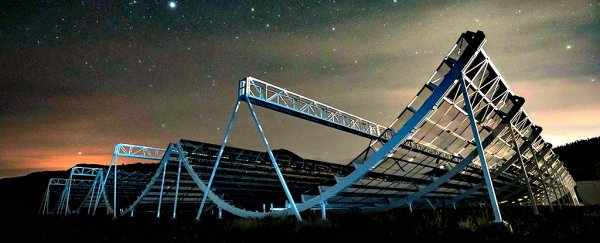Astronomers have detected yet another mysterious and powerful fast radio burst hitting Earth from an unknown source in space.
If that's not strange enough, this particular fast radio burst is incredibly low, in the 580 megahertz frequency range – nearly 200 MHz lower than any other fast radio burst we've picked up on before.
If you haven't heard of fast radio bursts (FRBs), they're some of the most explosive and mysterious events in the Universe.
They can generate as much energy as 500 million Suns in mere milliseconds, and there could be as many as one happening every second. The problem is, we still don't know what's causing them.
One of the signals we've detected has repeated, sending out multiple FRBs from the same location, and this has allowed us to pinpoint where in the Universe it's coming from (spoiler: not our galaxy).
But we still don't know for certain what caused it, or even if there are different varieties of FRBs coming from different sources. The vast majority signals we only ever detect once, which gives us very little to go off.
Now we have another anomaly to investigate.
According to a report in The Astronomer's Telegram, on the morning of 25 July 2018, an array of radio telescopes in British Columbia, Canada, detected a very strange FRB.
The fast radio burst has been named FRB 180725A after the year, month, and day it was detected.
The most interesting part is that the intense signal was transmitted in radio frequencies as low as 580 megahertz - making it the first detection of a FRB under 700 MHz.
The Astronomer's Telegram is a bulletin board of observations posted by accredited researchers - so while these are genuine detections, it's important to note that they haven't been peer reviewed as yet and independent teams haven't verified that the signals are from space.
That sounds like a silly thing to say, but let's not forget that back in 1998, researchers thought they had discovered a new type of radio signal coming from space, only to figure out 17 years later that it was coming from a microwave oven in their research facility. Or even the very recent rediscovery of Mars.
But so far, all signs point to this being a new and very interesting FRB detection.
"These events have occurred during both the day and night, and their arrival times are not correlated with known on-site activities or other known sources," Patrick Boyle, a project manager for the Canadian Hydrogen Intensity Mapping Experiment (CHIME), wrote in The Astronomer's Telegram.
So what do scientists think these weird signals could be?
The most recent research on the repeating FRB suggests the source is a neutron star, but other hypotheses for FRBs include black holes, pulsars with companion stars, imploding pulsars, a type of star called a blitzar, a connection with gamma-ray bursts (which we now know can be caused by colliding neutron stars), and magnetars emitting giant flares.
It's also increasingly likely that there's more than one explanation for the explosive events.
We should add that it's also not impossible that FRBs could be engines firing on giant alien spaceships, either, according to a Harvard physicist.
What we do know is that they cover a spread of frequencies - an even wider spread than initially thought, this new detection shows - and they seem to be coming from very far away, possibly billions of light-years. This suggests whatever is causing them has to be extremely energetic.
Regardless of their source, if we can get better at detecting them and understanding their origin, they could help unveil clues as to the origin of the Universe and the mysterious Epoch of Reonisation, the time during which the interstellar medium, primarily hydrogen, became ionised in the very early universe.
"FRBs are like incredibly powerful flashlights that we think can penetrate this fog [of the interstellar medium] and be seen over vast distances," said Anastasia Fialkov of the Harvard-Smithsonian Center for Astrophysics about another FRB discovery last year.
"This could allow us to study the 'dawn' of the Universe in a new way."
With new, powerful tools coming online that will help us detect more and more of these FRBs, scientists are optimistic it won't be long until we can narrow down where they're coming from, and, hopefully, what's causing at least some of them.
We'll be waiting white-knuckled for those results when they come in.
